Who Were the Amalekites?
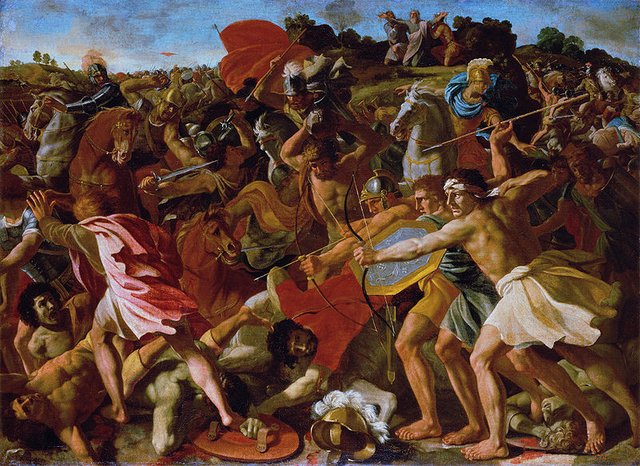
Rephidim, the Eleventh Station of the Exodus, was the site of some of the better-known incidents of the Exodus. It was here—or somewhere in the vicinity—that Moses first struck water from a rock. It was here that Moses was met by his father-in-law Jethro. And it was here that the Israelites engaged the Amalekites in battle:
Then came Amalek, and fought with Israel in Rephidim. And Moses said unto Joshua, Choose us out men, and go out, fight with Amalek: to morrow I will stand on the top of the hill with the rod of God in mine hand. So Joshua did as Moses had said to him, and fought with Amalek: and Moses, Aaron, and Hur went up to the top of the hill. And it came to pass, when Moses held up his hand, that Israel prevailed: and when he let down his hand, Amalek prevailed. But Moses hands were heavy; and they took a stone, and put it under him, and he sat thereon; and Aaron and Hur stayed up his hands, the one on the one side, and the other on the other side; and his hands were steady until the going down of the sun. And Joshua discomfited Amalek and his people with the edge of the sword. And the Lord said unto Moses, Write this for a memorial in a book, and rehearse it in the ears of Joshua: for I will utterly put out the remembrance of Amalek from under heaven. And Moses built an altar, and called the name of it Jehovahnissi: For he said, Because the Lord hath sworn that the Lord will have war with Amalek from generation to generation. (Exodus 17:08-16)
But who were the Amalekites?
Amalek
According to Genesis, Amalek, the father of the Amalekites, was a grandson of Esau:
Thus dwelt Esau in mount Seir: Esau is Edom. And these are the generations of Esau the father of the Edomites in mount Seir: These are the names of Esau’s sons; Eliphaz the son of Adah the wife of Esau, Reuel the son of Bashemath the wife of Esau. And the sons of Eliphaz were Teman, Omar, Zepho, and Gatam, and Kenaz. And Timna was concubine to Eliphaz Esau’s son; and she bare to Eliphaz Amalek: these were the sons of Adah Esau’s wife. (Genesis 36:08-12)
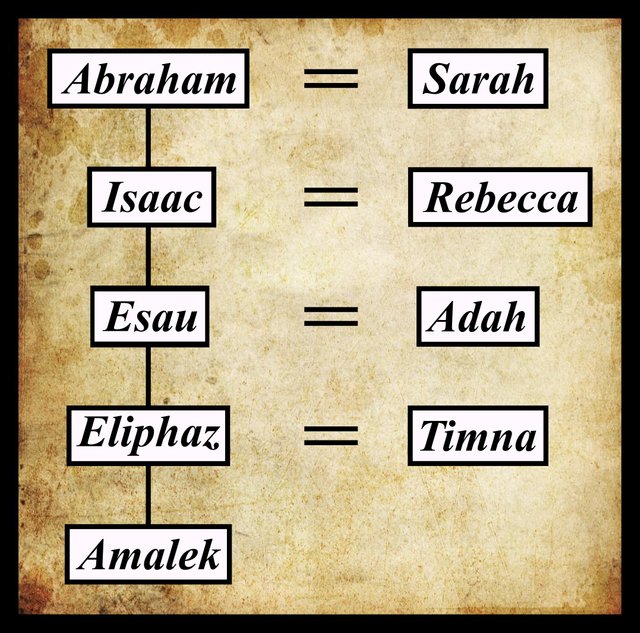
Following this tradition, the conventional view is to regard the Amalekites as a small and insignificant tribe of Edomites, who dwelt in the vicinity of the Negev and neighbouring regions of Sinai. They are not mentioned in any Egyptian, Babylonian or Assyrian sources, and no archaeological remains have ever been ascribed to the Amalekites.
Nevertheless, in Numbers 24:20 Amalek is called the first of the nations:
there shall come a Star out of Jacob, and a Sceptre shall rise out of Israel, and shall smite the corners of Moab, and destroy all the children of Sheth. And Edom shall be a possession, Seir also shall be a possession for his enemies; and Israel shall do valiantly. Out of Jacob shall come he that shall have dominion, and shall destroy him that remaineth of the city. And when he looked on Amalek, he took up his parable, and said, Amalek was the first of the nations; but his latter end shall be that he perish for ever. (Numbers 24:17-20)
Much ink has been spilt by Biblical commentators concerning the correct interpretation of this passage. How could a minor tribe of Edomites be considered the first of the nations?
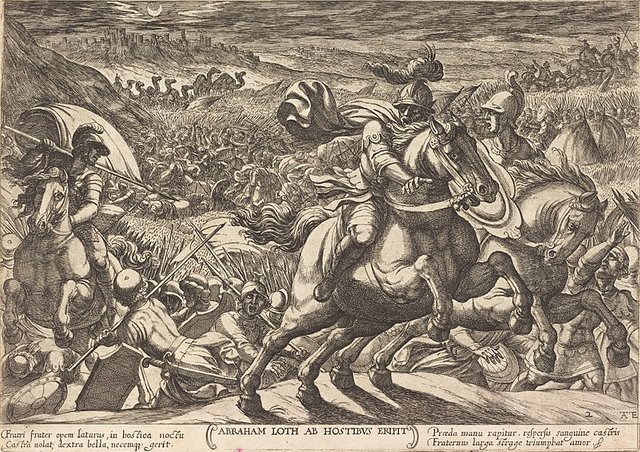
There is also the troubling fact that the Amalekites are also mentioned in connection with the war between the Four Great Kings and the Five Cities of Plain, which took place before the birth of Esau:
And it came to pass in the days of Amraphel king of Shinar, Arioch king of Ellasar, Chedorlaomer king of Elam, and Tidal king of nations; That these made war with Bera king of Sodom, and with Birsha king of Gomorrah, Shinab king of Admah, and Shemeber king of Zeboiim, and the king of Bela, which is Zoar. All these were joined together in the vale of Siddim, which is the salt sea. Twelve years they served Chedorlaomer, and in the thirteenth year they rebelled. And in the fourteenth year came Chedorlaomer, and the kings that were with him, and smote the Rephaims in Ashteroth Karnaim, and the Zuzims in Ham, and the Emins in Shaveh Kiriathaim, And the Horites in their mount Seir, unto Elparan, which is by the wilderness. And they returned, and came to Enmishpat, which is Kadesh, and smote all the country of the Amalekites, and also the Amorites, that dwelt in Hazezontamar. (Genesis 14:1-7)

A Velikovskian Digression
In From the Exodus to King Akhnaton, the first volume of Ages in Chaos, Immanuel Velikovsky identifies the Amalekites with the Hyksos, a foreign people who invaded and conquered Egypt at the end of the 13th Dynasty. He theorizes that the Exodus took place at the same time as the Hyksos invasion of Egypt. According to the Short Chronology, which I espouse, the Exodus occurred at the end of the Hyksos period, not the beginning.
In support of his identification, Velikovsky cites several Arabian historians, among whom the best known is probably Al-Masudi.
Abu al-Hasan Ali ibn al-Husayn al-Mas‘udi was an Arab polymath of the 10th century. His encyclopaedic Meadows of Gold and Mines of Gems, a history of the World from the Creation, has earned him the sobriquet of The Herodotus of the Arabs. A French abridgment, L’Abrégé des Merveilles (1898), and a nine-volume French translation, Prairies d’Or (1861-77), are available on the Internet Archive. (Volume 9 of the latter includes a general index.)
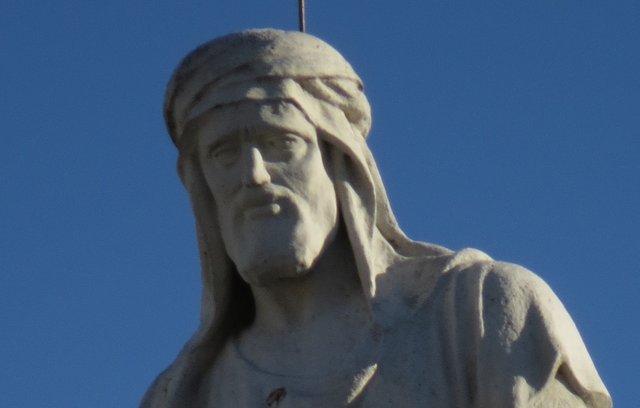
Al-Masudi provides Amalek, the father of the Amalekites, with a different genealogy to that found in Genesis:
Shem established himself in the middle of the Earth ... Aram and Arphaxad, both sons of Shem ... and the descendants of ... Amalek, son of Lot son of Aram, came to inhabit either the Holy Land or Syria. He was the father of the Amalekites who settled in many countries. (Prairies d’Or 1:77-78)
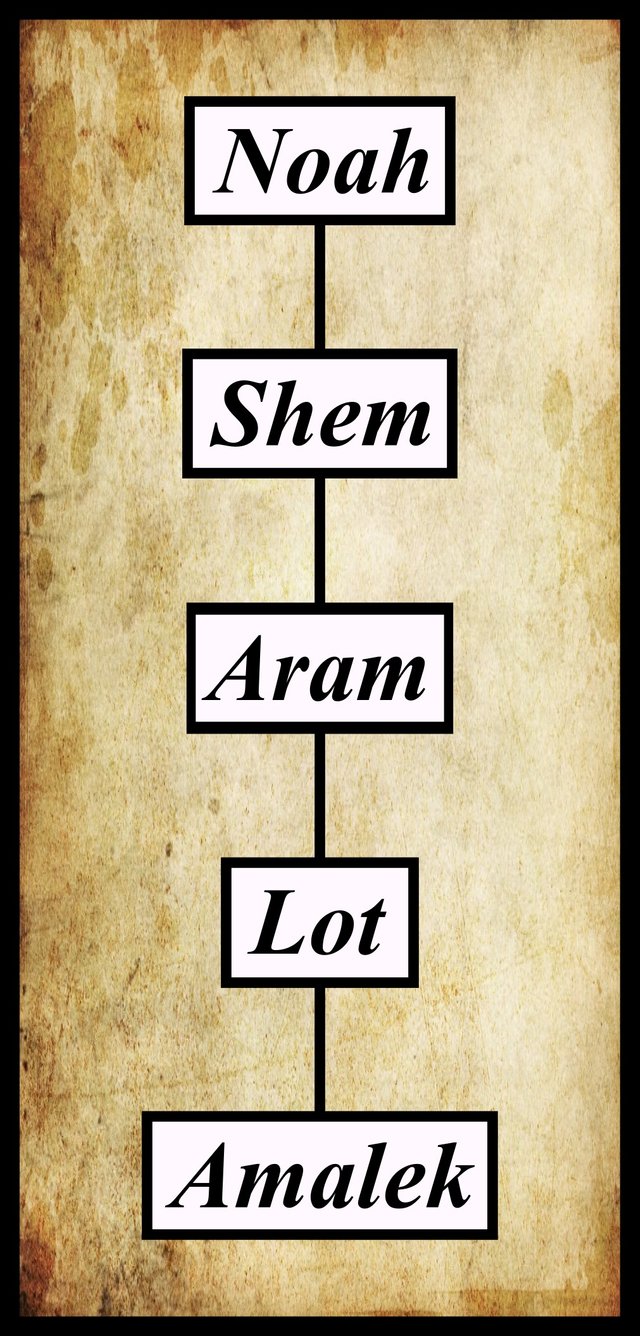
But in Volume 2, Al-Masudi records the Biblical genealogy of Amalek, albeit the name of Amalek’s father differs from that in Genesis:
Esau begot thirty sons ... It has been said that the Amalekites, Arab Bedouins inhabiting Syria, were descended from en-Nefar, son of Esau. (Prairies d’Or 2:294-295)
Velikovsky suggests that later individuals with the name Amalek have been mistakenly identified with the Father of the nation:
The Amalekites were an old Arabian tribe who, from ancient days, dominated Arabia. In the Book of Genesis, in a genealogical table, Amalek is said to have been an offspring of Eliphaz, son of Esau, Isaac’s son. But obviously this statement does not refer to the Amalek who was father of the tribe. The Book of Genesis also has another record: as early as before the destruction of Sodom the Amalekites were at war with the kings of the Two-Stream Land, a mighty coalition. The Amalekites who participated in these battles in the days of Abraham could not have been descendants of Amalek, descendant of Esau, himself a descendant of Abraham. The Amalekites were thus of an older clan and no kinsmen of the Twelve Tribes. (Velikovsky 60)
The most striking thing about Al-Masudi’s account of the Amalekites is his description of an Amalekite Dynasty ruling in Egypt for several generations:
An Amalekite king, el-Walid, son of Douma, came from Syria, invaded Egypt, conquered it, made himself Pharaoh, and occupied the throne without dispute till his death. He was succeeded by his son er-Reyan, the Amalekite. He was the Pharaoh contemporaneous with Joseph, the one mentioned by Allah while recounting the story of Joseph in the Koran ... The following kings of Egypt were: Darem, son of Reyan the Amalekite; Kames, son of Madan the Amalekite, and el-Walid, son of Mosab. the latter was the Pharaoh of Moses’ time, but scholars are not agreed about his origins. Some consider him an Amalekite, whilst others have him come from Lakhm, a city in Syria; and others place him amongst the Copts descended from Misr, son of Baisar. His surname was Zoulmi (the tyrant) ... This Pharaoh was drowned while pursuing the Israelites, who, leaving Egypt under the guidance of Moses, crossed the Red Sea dryshod, thanks to a miracle. (Prairies d’Or 2:397-399)
Significantly, Al-Masudi places the Amalekite invasion of Egypt before Israel’s Sojourn in Egypt. Joseph comes to Egypt during the reign of the second Amalekite Pharaoh, and the Exodus takes place at the end of the Amalekite Dynasty—exactly as hypothesized by the Short Chronology. Velikovsky, to be fair to him, does mention this discrepancy before rejecting it:
Many ancient Arab writers recorded the invasion of Egypt by the Amalekites. There is a great deal of fancy in some of these stories. In several instances they are spoiled by the clumsy attempts of these authors to adapt their Arab traditions to the traditions of the Hebrews, but not to the correct ones. So it happens that Joseph was sold into Egypt when an Amalekite was the pharaoh, or that Moses left Egypt when an Amalekite was the pharaoh. An Arab author admitted that there was no concurrence as to the race of the pharaoh who reigned at the time of Moses, whether he was a Copt, a Syrian, or an Amalekite.
We shall disregard these attempts of some Arabian authors to insert stories culled from the biblical narrative into stories indigenous to the Arabian peninsula, and we shall devote our attention only to the narratives which did not have their source in the Bible or the Haggada. They must have been autochthonous and transmitted from generation to generation on the Arabian peninsula. (Velikovsky 63)
Al-Masudi’s account of the immediate aftermath of the Expulsion of the Hyksos is also worthy of note:
The destruction of Pharaoh and his army made the children, women and slaves who had remained in Egypt fearful of being attacked by the kings of Syria or the West. So they placed a woman celebrated for her wisdom and prudence, Deloukeh [Daluka], on the throne. She surrounded all Egypt with a wall guarded by troops, and she established relay posts close enough to one another to allow communication between them by spoken word ... It is said that Deloukeh constructed this wall to protect her son, who was a passionate hunter, as much of wild animals and monsters in the Nile as of the neighbouring kings and nomads. Furthermore, she placed around the outer wall crocodiles and other fearsome creatures. (Prairies d’Or 2:398-399)
The identity and historicity of Daluka remain uncertain, but there was a notable female Pharaoh shortly after the expulsion of the Hyksos: Hatshepsut of the 18th Dynasty. Hatshepsut was a prolific builder, though she is not known to be responsible for strengthening Egypt’s eastern defences. Nevertheless, there is much evidence that the eastern frontiers of Egypt were strengthened after the expulsion of the Hyksos by an elaborate system of walls and canals. As we saw in an earlier article in this series, there is even a celebrated 19th-Dynasty carving depicting one of Al-Masudi’s crocodile-infested canals:
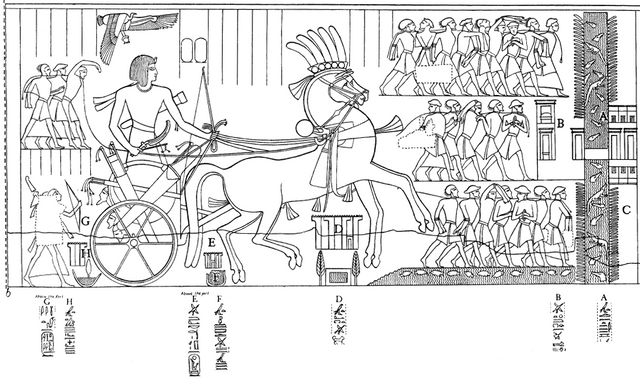
Al-Masudi later summarizes things:
Despite their differences, the chronicles agree on the number of kings of Egypt, namely: 32 Pharaohs; 5 kings of Babylon; 4 kings among the kings of Mareb or Amalekites, who came from Syria; 7 from the lands of Rome; finally 10 Greek kings. That is for the time before Christ, without including the Persian kings who occupied Egypt before the Kosroes. The total duration of the reigns of these kings, Persian, Roman, Amalekite and Greek, was 2300 years. (Prairies d’Or 2:413)
In Volume 3, Al-Masudi speaks of the Amalekites migrating to Tihamah under their king Es-Samayda in search of water during the lifetime of Abraham (Prairies d’Or 3:91-92). Later in the same volume, we are told:
Noah departed with his children and his followers, and, as we have already recounted, he came to occupy Al-Yamama. After him, Amlak, son of Lot son of Aram son of Shem son of Noah, set out with his children and his followers ... These settled in the farthest parts of the Holy Lands and in the lands adjacent to the sea. Some of them, however, went in the direction of Egypt and the Maghreb, where, as we have already remarked, several reigned as Pharaohs (Hyksos?). We have also reported, in an earlier chapter, the opinion of those who, associating the Amalekites and other peoples previously named with Esau, son of Isaac son of Abraham, claim that they are actually his descendants. These Amalekites have had many kings who formerly dwelt in many different countries, whether in Syria or elsewhere. In our Historical Annals, we have recounted their history, describing their empire and the wars they had to endure. (Al-Masudi 3:273-274)
I can’t read Arabic, so I do not know whether it was Al-Masudi himself or his 19th-century French translators who inserted that Hyksos in parentheses.
On more than one occasion Al-Masudi describes the Amalekite invaders of Egypt as coming from Syria. This is not what one would expect if the Amalekites were an Arabian tribe, but it is exactly what one would expect if the Hyksos invaders were Assyrians. Is it possible that the Assyrians and their local Arabian allies have been confused or conflated?
Al-Masudi’s history, I believe, is more supportive of the Short Chronology than it is of Velikovsky’s reconstruction.
Yaqut al-Hamawi and Al-Samhudi
Another Arabian historian cited by Velikovsky was Ali ibn Ahmah al-Samhudi, who lived from 1440-1503. Velikovsky gives his dates as 844-911, which are AH (Islamic years after the Prophet’s Flight from Mecca). His Wafa al-Wafa [The Fulfilment of Faithfulness] is a comprehensive five-volume work on the City of the Prophet (Medina). I do not know if there is an English translation of this work.
Velikovsky’s quotation of Al-Samhudi is translated from the Geschichte der Stadt Medina [History of the City of Medina] by Ferdinand Wüstenfeld, a German abstract of Al-Samhudi’s work. The latter is himself citing the 13th-century Byzantine geographer Yaqut al-Hamawi, who in turn is citing the 9th-century Arabian historian Ibn Abd al-Hakam:
The Amalekites reached Syria and Egypt and took possession of these lands, and the tyrants of Syria and the Pharaohs of Egypt were of their origin. (Velikovsky 64, Wüstenfeld 26)
Who is Abd al-Hakam referring to by the expression the tyrants of Syria? Could these be Assyrian Emperors? According to mainstream archaeology, Shamshi Adad I, the founder of a prominent Old Assyrian dynasty, was not an Assyrian but an Amorite. Could there be a link between Amorite and Amalekite? The L/R Split is common in linguistics, but that’s a rather slender base on which to found such a radical hypothesis. Moreover, the current view is that the Amorites spoke a Northwest Semitic language, while Assyrian is a East Semitic language and Arabic is generally placed on a third branch of this language family.
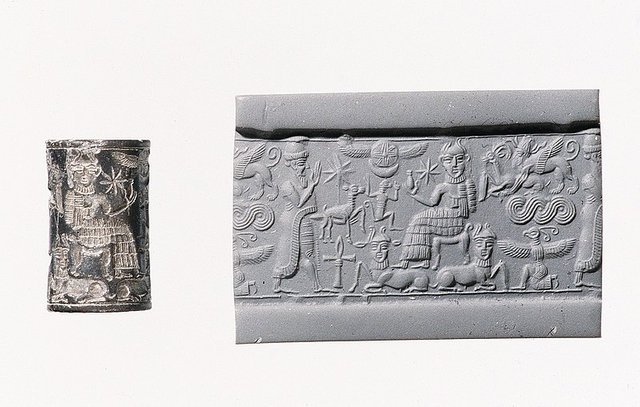
Assyrians
According to The Short Chronology, the Hyksos were the Imperial Assyrians—a hypothesis which I believe was first proposed by Gunnar Heinsohn. The Hyksos Empire, the Old Assyrian Empire and the Akkadian Empire were one and the same, though mainstream archaeologists continue to regard them as three different empires and to place them in three different epochs (The Restoration of Ancient History). In the Short Chronology they belong roughly to the years 900-700 BCE.
Does this mean that we should identify the Amalekites with the Assyrians? Possibly. It is known, however, that the Assyrians often appointed allies to rule over foreign lands for them. For example, Scythian dynasties were established by the Assyrians in the cities of Lower Mesopotamia (such as Ur). It is possible, then, that the Amalekites were a local but powerful Arabian tribe, who allied themselves with the invading Assyrians and were deputized to govern Egypt on behalf of the Assyrians.
If this hypothesis has any merit, then it would be entirely unsurprising if the Amalekites were sometimes regarded as Arabs and sometimes as Assyrians.
Conclusion
In conclusion, I am going to make the following hypothesis:
The Amalekites were an ancient Arabian tribe, once powerful and widespread in the Arabian Peninsula.
Following the catastrophe of 1500 BCE, which brought the last phase of the Ice Age (the Younger Dryas) to an abrupt end, they migrated to Sinai and its environs.
When the Assyrians invaded this region, the Amalekites submitted to them and became their allies.
When the Assyrians invaded Egypt, the Amalekites accompanied them, perhaps even making up the bulk of the invading force.
The Assyrians then appointed the Amalekites to govern the country for them. These Amalekite rulers were the Hyksos Pharaohs. During this time, there may have been a considerable amount of intermixing between these two Semitic peoples.
When the Assyrians were expelled from Egypt, the local Amalekites accompanied them back to Assyria.
There is so much more that could be said on this subject, and it requires much more and thorough research, but in this series of articles our primary concern is to devise a working chronology of the ancient Israelites. So let us leave it at that and resume our journey in the footsteps of Moses and the House of Israel.
To be continued ...
References
- Gunnar Heinsohn, The Restoration of Ancient History, Mikamar Publishing, Portland OR
- Al-Masudi, Charles Barbier de Meynard, Abel Pavet de Courteille, Les Prairies d’Or, Volumes 1-9, La Société Asiatique, Paris (1861-1877)
- Al-Masudi, Carra de Vaux (translator), L’Abrégé des Merveilles, Actes de la Société Philologique, Volume 26, C Klincksieck Paris (1898)
- William H Shea, A Date for the Recently Discovered Eastern Canal of Egypt, Bulletin of the American Schools of Oriental Research, Number 226 (April 1977), pp 31-38, Washington DC (1977)
- Immanuel Velikovsky, From the Exodus to King Akhnaton, Ages in Chaos, Volume 1, Paradigma Ltd (1952, 2009)
- Ferdinand Wüstenfeld, Geschichte der Stadt Medina: In Auszuge aus dem Arabishen des Samhûdi [History of the City of Medina: An Abstract from the Arabic of al-Samhudi], Dieterich’schen Verlagsbuchhandlung, Göttingen (1860)
Image Credits
- Joshua’s Victory Over the Amalekites: Nicolas Poussin (artist), Hermitage Museum, ГЭ-1195, Public Domain
- Abraham Rescues Lot from His Enemies: Antonio Tempesta (artist), National Gallery of Art, Washington DC, Public Domain
- Immanuel Velikovsky: Donna Foster Roizen (photographer), © Frederic Jueneman, Creative Commons License
- Al-Masudi: Naturhistorisches Museum Wien, Photo by Manuela Gößnitzer, Creative Commons License
- A Relief of Seti I with a Crocodile-Infested Canal (Karnak Temple): Alan H Gardiner, _The Ancient Military Road between Egypt and Palestine, _Journal of Egyptian Archaeology, Volume 6, Number 2, Plate XI, The Egypt Exploration Society, London (1920)
- Old Assyrian Cylinder Seal and Modern Impression: Metropolitan Museum of Art 1991.368.5, New York, Public Domain

This post was shared in the Curation Collective Discord community for curators, and upvoted and resteemed by the @c-squared community account after manual review.
@c-squared runs a community witness. Please consider using one of your witness votes on us here
nice historical post